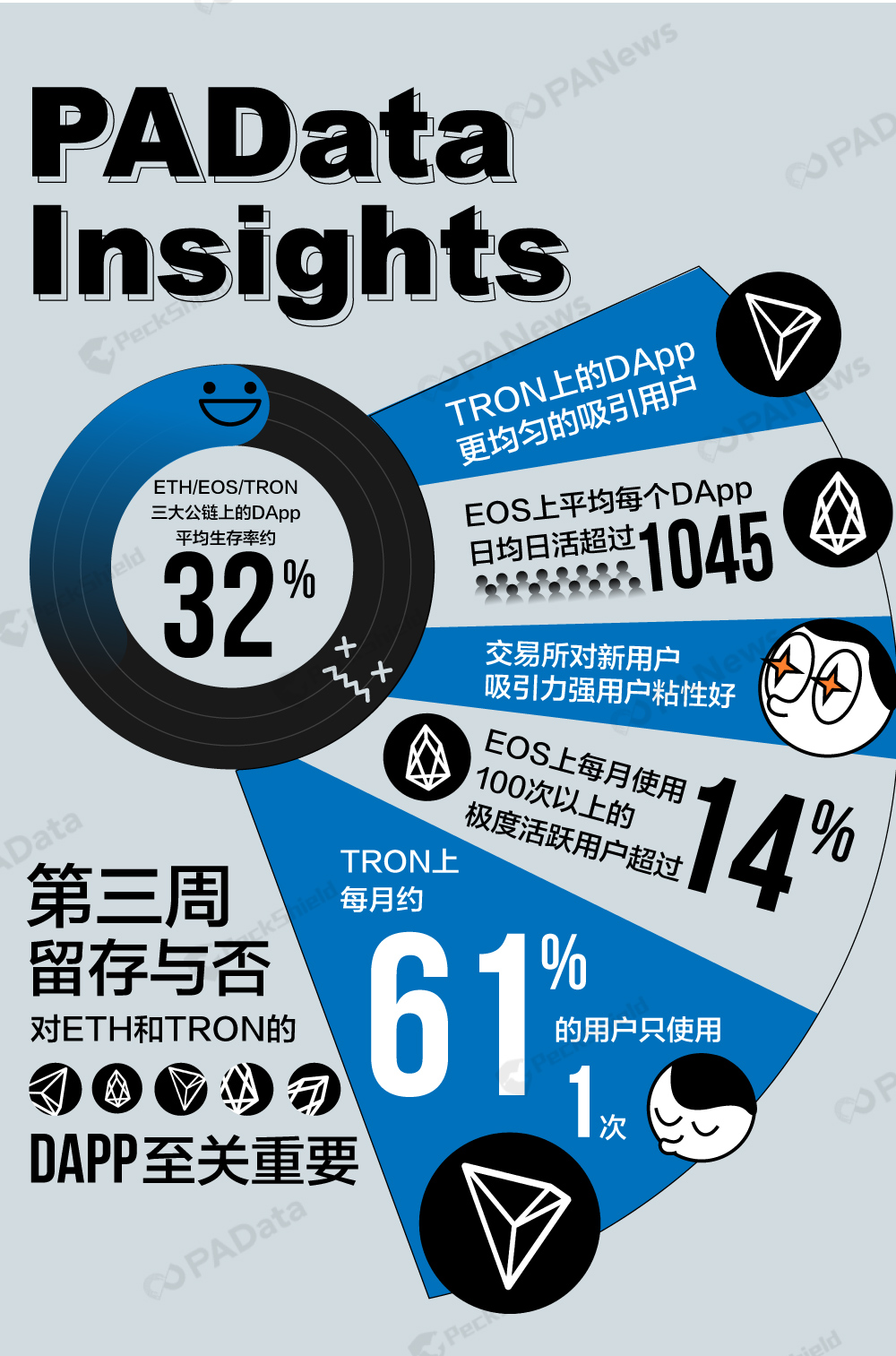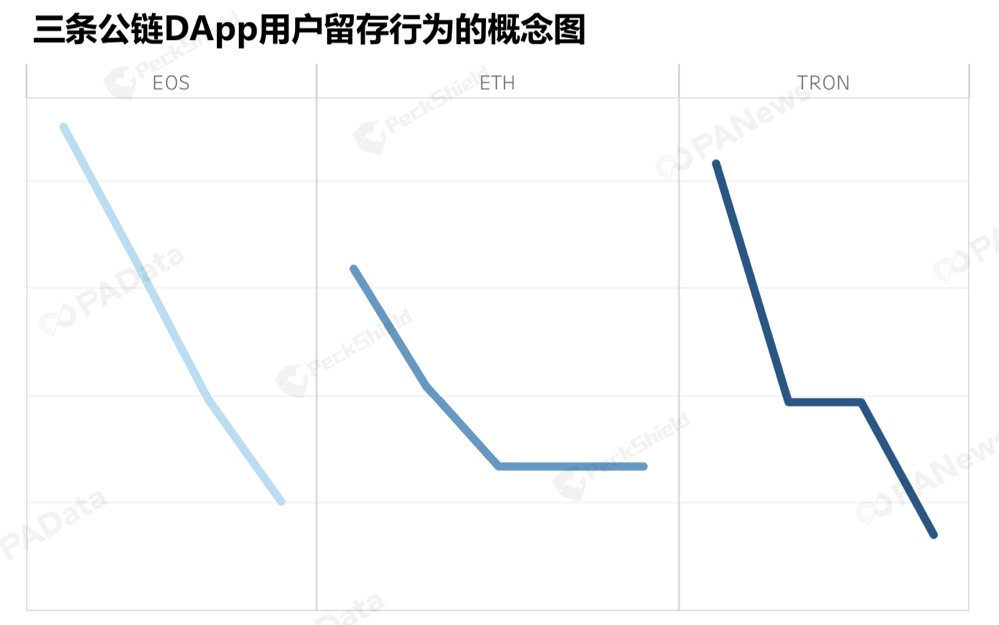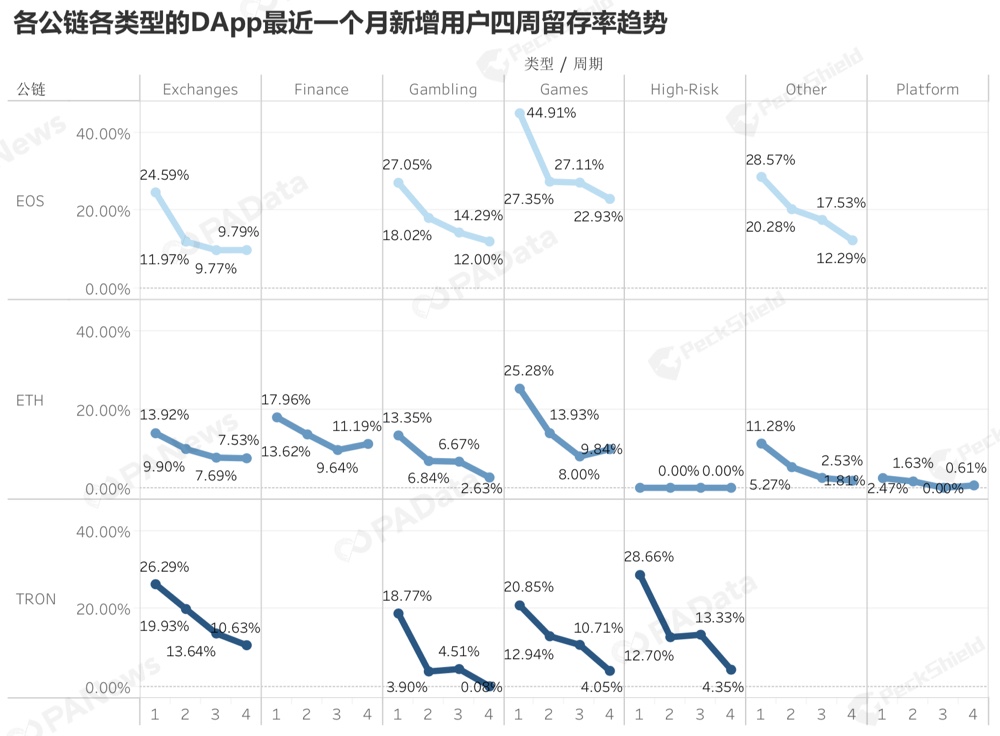DApp's "AARRR" User Operation Strategy (on) | PANews Report Interpretation
This article is an excerpt from the report "DApp "AARRR": ETH/EOS/TRON three public chain DApp user portrait study" (on).
Click to view the content of the pilot: Who is using DApp? ETH/EOS/TRON user portraits are all secret
The main problem facing the development of DApp today is not unmanned development, but how to operate to make DApp “live” for a long time and “live” better.
As a new thing in the Internet products, DApp will inevitably reflect the thinking of Internet product operation in the formation of its operation mode. The "AARRR" model, the "La New-Activate-Retain-Transfer-Redirect" operating model, has matured in the development of Internet products. The first part will focus on the performance of DApp in the three aspects of pulling, activating and retaining.
- Market Analysis: BTC slowly climbed the resistance level, and it was a long and short matchup.
- Google zooms in and builds a hybrid cloud blockchain application using ChainLink Oracle
- DeFi Lending Overview | May 2019 News

PAData Inghts: 1. The average survival rate of DApp on the three major ETH/EOS/TRON chains is about 32%. An average of 16% of DApps on EOS/TRON are prosperous. 2. TRON is one of the two DPC new capabilities in the three public chains. The user is more evenly attracted. On average, each DApp pulls 45 new people every day. The exchange is most attractive to new users. 3. EOS's overall daily average is the highest, with an average daily average of more than 1,045 people per Dapp. Exchange and game users are more active. 4. More than 60% of users on ETH use DApp less than 10 times a month. About 70% of users use EOS more than 10 times a month, and more than 14% of extremely active users use more than 100 times. The percentage of users who use less than 10 times a month on TRON is about 80%, but most of them use only once. 5. The DApp on EOS is the highest average retention rate in the four weeks, with an average of 28.57% in the first week and 12.12% in the fourth week.
DApp pulls new capabilities to differentiate
Leading class DApp is lower than the overall level
From the perspective of DApp's new overall performance on different public links, the average performance of DApp on EOS is closer to ETH, and DApp's new ability is more serious. This means that users are more likely to be individual projects. attract. This presents a possibility from the opposite side. In the three public chains, EOS and ETH are more likely to have influential DApps.
If you add the type of DApp to the survey dimension, you can see that there are obvious differences in the ability to pull new DApps on the three public chains.

On average, FDA's financial and financial DApps are the most widely added DApps in the day, and are higher than the overall level of ETH. The largest number of game-based DApps, 50% of DApps have an average daily increase of only 9.5 people, not only lower than financial and financial categories, but also lower than DJs of exchanges, gambling, other classes and platforms. Sixth place. But the game-like DApp is very polarized, either attracting a lot of users or attracting very few users.
In the DApp ecosystem of EOS, the daily increase in the number of DApps in games and exchanges is relatively concentrated, and the average daily average number of DApps (median) is much higher than the overall level. As the dominant type in the EOS ecosystem, the daily average number of gambling DApps is lower than the overall level of the DApp ecosystem on EOS. Like ETH, the EOS ecosystem has also experienced a serious differentiation of the dominant DApp internal pull-up capabilities.
In TRON, the daily average number of DApps on exchanges and games is higher than the overall level of DApp on TRON, and the dominant high-risk DApp is lower than the overall level. The game-like DApp is the worst-performing DApp of all types, and it means that most of the games on TRON are “end of death” except for a few.
Individual DApp pulls high overall day
Three user active structures appear
From the daily average daily data of the 50 most popular DApps in April, EOS has the highest daily average daily activity, followed by TRON. On the ETH, more than 50% of DApps have an average daily life of only 87 people, which is the least active public chain among the three DApp ecosystems. The daily activity of DApps on the three public chains indicates that the current prosperity of the DApp ecosystem is not a common prosperity, and the prosperity of individual DApps has not formed a radiation effect.
The type of DApp has an impact on its user activity, and the impact is more obvious. In the three DApp ecosystems, each of the dominant DApps is not the most active type. Subverting stereotypes is that on ETH, gambling and exchange-like DApps outperform mainstream game-based DApps; on EOS, other classes and game-like DApps outperform mainstream gambling DApps; On TRON, the exchange performed better than the mainstream high-risk DApp. However, as the dominant DApp, ETH games and EOS's gaming DApps are more healthy than other classes, which is mainly reflected in the fact that there are no intermediate faults in the distribution of daily averages and daily averages of the two types of DApps. The phenomenon of serious magnitude differentiation.

According to the number of active times of the user, an active structure diagram of each public chain DApp user can be generated. According to the number of times the user uses the DApp every month, the user can be divided into "inactive users who use only 1 time", inactive users who use "1 to 10 times", active users who use "10 to 100 times", and "use". Extremely active users of more than 100 times. The percentage of these four types of users as a total user (stacked from bottom to top in the figure below) constitutes a user-active structure.

From the user-active structure chart from January to April this year, ETH's DApp user ecology presents a stable slender vertebral structure at the bottom, which means that although the user is relatively stable and mature, ETH's DApp lacks these. Users become attractive to deep users. EOS's user-active structure presents a "big middle, small ends" style, meaning that EOS's DApp needs more attention to pull new. TRON's user structure presents a "pyramid" style, indicating that the DApp on TRON lacks a productive means to activate new users.
Retention rate has nothing to do with the number of new additions
The third week of retention is critical to ETH and TRON
Retention refers to the behavior of a user using a DApp after a certain period of time and using the DApp again after a period of time. Retention rate refers to the percentage of users who have retained the total number of users.
Taking the three public chains of ETH, EOS and TRON as the main classification dimensions to observe the four-year retention rate of the 50 most popular DAUs in April (the highest daily average DAU), you can see that the DApp on EOS is the four-week average. The highest retention rate is the current user's most sticky ecology.

On the whole, the retention rate of DApp users on the three public chains has decreased over time. However, the retention rate of each public chain changes at different time periods, which in turn presents different user behaviors. If the abstraction summarizes the retention behavior of three public-chain DApp users, EOS may approach a slash, ETH may be close to an obtuse angle, and TRON may be close to "stepped."
For EOS, the retention rate for the second week was the most significant, requiring DApp developers to focus on this point in time. For ETH and TRON, the retention rate for the third week is a turning point. The retention rate of ETH for the third week is equivalent to directly increasing the overall retention rate. It is important for TRON to increase the retention rate for the third week, which may be important for slowing the loss of the fourth week. effect.

The DApp type has an impact on user behavior stickiness, and it is interesting to note that the analysis of the behavioral stickiness of each public chain DApp user once again corroborates the view in the user activity level analysis that the mainstream DApp type does not represent the preferred direction of user behavior. For example, in the EOS ecosystem, the mainstream type of gaming DApps, user activity and user stickiness are not the best, but the game class and others are DApp types with better user stickiness. Users of financial and financial DApps in ETH are more sticky. The mainstream type of high-risk DApp on TRON is also not the best user-friendly category.

It is also worth noting that the number of new users and the retention rate are not statistically related, that is, the more people who are not new, the more they will survive. This means that in the case of limited current inventory users, killing the incremental market is only a way to achieve growth, and may not be the optimal path. Keeping the stock market in reserve for further development may be a more efficient way to grow.
Source | PANews.io Data Support | Peckshield, DappTotal
We will continue to update Blocking; if you have any questions or suggestions, please contact us!
Was this article helpful?
93 out of 132 found this helpful
Related articles
- She Knows | Kill Wall Street? This is not what DeFi has to do!
- finally come! The Bitcoin futures contract of the Bakkt exchange of the parent company of the NYSE will open the test on July 22.
- Academic orientation makes Bitcoin more secure, how does the Erlay protocol save 84% of the bandwidth of the node?
- The most stringent regulation in the history of digital currency? Sorry, there may be misunderstandings
- How to solve problems in Bitcoin and Ethereum programming models
- "618" shopping festival e-commerce giants trick play blockchain experts said that relying on "chain" to solve commodity security "a little difficult"
- 5G+ blockchain, is it a gimmick, or is it possible in the future?






